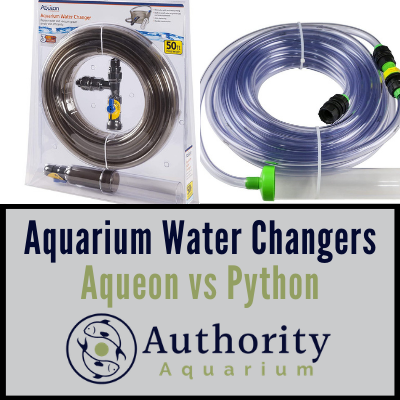Last Updated on April 23, 2023 by Coral Realm
Keeping the water in your fish tank clean is vital for the health of fish, and for the overall look of your aquarium. Toxins build up very quickly in the water and can be very harmful for your fish if left. Cleaning the substrate is also very important; think about where all that fish poop sinks to!
Changing the aquarium water and cleaning the substrate needs not be a complete hassle. Taking out the water in buckets is messy and tiresome, and cleaning the substrate can feel impossible! Products like the Aqueon Water Changer and the Python aquarium maintenance system make the whole process quicker and easier.
Both of these aquarium vacuum cleaners do a great job and are brilliant products. In this article we look at the Aqueon Water Changer vs Python Water Changer, and see the similarities and differences, and try to find out which is the best aquarium water changer!
IN THIS ARTICLE
Aqueon Water Changer vs Python Water Changer

Similarities:
Both the Aqueon water changer and the Python water changer aquarium maintenance system offer a similar way to change the water and to clean the substrate. All you need to do is attach the system to a faucet and the pressure of flowing water acts as a pump which draws out the water from your tank. You can then fill the tank back up the same way.
They both offer a no spill solution to cleaning the tank and use a gravel tube which cleans the substrate as the water is being drawn out through the pipe. Both the Aqueon Water Changer and Python Water Changer have a good substrate cleaning tube which will remove all the dirt and debris.
Cleaning the substrate is very important in maintaining good water chemistry. As organic waste such as fish feces, plant matter, and excess fish food decompose on the bottom of the tank it releases ammonia, which is very toxic to fish. Ammonia is then converted to nitrite, which is also very dangerous. This in turn is converted to nitrate which can drive algal blooms if in too high concentration, as it is an important source of nitrogen in plants. Removing decomposing debris is very important in removing the source of these issues before they form.
Size and Weight:
The size and weight can be pretty important, as you’re going to be using this piece of kit quite regularly. You also need to know if it can fit in your storage easily.
The Python maintenance system has a size 15 x 15 x 2 inches, which is a bit on the smaller side. It isn’t that heavy either, only weighing 2.8 pounds.
The Aqueon water changer is a little bigger than the Python at 17.7 x 21 x 2.7 inches, and coming in at a weighty 4.8 pounds.
Both water changers are a practical size and should easily fit into your storage. If you really need to save on space though the Python maintenance system wins this round.
Tubing:
Both the Aqueon water changer and the Python water changer have long tubes which allow you to connect to the water supply, so you can put those buckets down and let the tube do the work.
The Python offers a 25- and 50-foot-long tubing, which should be plenty to connect to your faucet. It comes with a 10-inch gravel cleaning tube, but you can upgrade to 20, 24, or 72 inches depending on the size of your aquarium tank.
The Aqueon also offers an option of a 25- or 50-foot tube, so if your faucet is that bit further away it’ll be no trouble for the 50-foot-long tubing. The gravel tube is 11 inches long, which should be plenty in reaching the bottom of your tank and cleaning that pesky substrate.
Both of these aquarium water changer systems should be plenty long enough to reach your faucet to make cleaning your tank easy and hassle free as they offer differing lengths depending on your need. If you have a very deep aquarium the Python will be useful as you can choose a longer gravel cleaning tube.
Construction
You need the water changer you buy to be nice and sturdy. It’s going to be pumping lots of water through, so you don’t want it to break and get a leak anytime soon! A poorly constructed aquarium water changer can be an absolute nightmare; they have been the scourge of carpets and flooring everywhere!
The Python aquarium maintenance system seems to have the edge here, as the general consensus is that Python comes that little bit more durable than Aqueon. This isn’t to say that if you buy the Aqueon it will be broken after one use! Just that the Python has a durability which seems to be a cut above.
Setup
The setup process does tend to change model to model, so make sure you check what you buy.
Buyers of the Aqueon Water Changer have complained that it can be a bit complicated, with a lot of different parts and bits and pieces. So it may take a little more time getting all set up. The manual is a little confusing too, so make sure you take time to read it thoroughly and understand what you need to do..
The Python Water Changer has a reputation of being a lot simpler and easier to set up and get going with. The manual is easy read, and lots of the parts are already ready to go. So you save time and hassle not having to fiddle with them.
Problems
There is one issue with both the Aqueon Water Changer and Python Water Changer that can cause a problem. The method of powering aquarium water changers with a faucet is fine when you are taking water out of the tank, but can have issues when putting new water in.
Tap water contains toxins and contaminants such as heavy metals, chlorine, and chloramine. These are incredibly toxic and dangerous to aquarium fish. Normally you would use an aquarium water conditioner to make the water safe before you put the new water in the tank. However if you use one of these water changers which uses the faucet, it pumps tap water into the tank to fill it back up. In general the consensus amongst aquarists is that putting water conditioner into the tank after or during refilling is totally fine and works just as well, but it is up to you.
The other problem is that the tap water is often at a different temperature than the aquarium water. If you don’t have a faucet where you can change the temperature of the water to match the tank water it can be a problem. Sudden changes in temperature can cause fish, especially tropical aquarium fish, great stress.
However a solution to both of these problems is to use the aquarium water changer to pump new water into a big bucket, where you can use the water conditioner and a spare aquarium heater to ensure it is the same temperature as the aquarium. Many heaters have a thermometer attached, if not, aquarium thermometers are pretty cheap to pick up. Once it is at the required temperature you can use a basic water pump to transfer the new water into the aquarium. You don’t need a powerful pump here, as all you are doing is transferring water, the flow rate doesn’t matter!
Conclusion – Aqueon Water Changer vs Python Water Changer
Both are pretty similar as they offer a similar thing and will both do the job nicely. They have the same length of tubing, but the Python Water Changer is smaller and lighter than the bulkier Aqueon Water Changer. The Python also seems to be the more robust and durable of the two.
We will leave the decision to you, but it does seem to be leaning the way of the Python Water Changer!
Check out the videos below for more information on both of these products and how to properly use them:
Aqueon Water Changer:
Python Water Changer:





